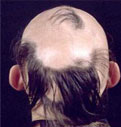


What is alopecia areata? & Classification
 Alopecia areata is a hair-loss condition which usually affects the scalp. It can, however, sometimes affect other areas of the body. Hair loss tends to be rather rapid and often involves one side of the head more than the other.
It is a condition affecting humans, in which hair is lost from some or all areas of the body. Because it causes bald spots on the scalp, especially in the first stages, it is sometimes called spot baldness. In 1%–2% of cases, the condition can spread to the entire scalp (Alopecia totalis) or to the entire epidermis (Alopecia universalis).
Alopecia areata affects both males and females. This type of hair loss is different than male-pattern baldness, an inherited condition
Classification
The most common type of alopecia areata involves hair loss in one or more round spots on the scalp.
Alopecia areata is a hair-loss condition which usually affects the scalp. It can, however, sometimes affect other areas of the body. Hair loss tends to be rather rapid and often involves one side of the head more than the other.
It is a condition affecting humans, in which hair is lost from some or all areas of the body. Because it causes bald spots on the scalp, especially in the first stages, it is sometimes called spot baldness. In 1%–2% of cases, the condition can spread to the entire scalp (Alopecia totalis) or to the entire epidermis (Alopecia universalis).
Alopecia areata affects both males and females. This type of hair loss is different than male-pattern baldness, an inherited condition
Classification
The most common type of alopecia areata involves hair loss in one or more round spots on the scalp.
- Hair may also be lost more diffusely over the whole scalp, in which case the condition is called diffuse alopecia areata.
- Alopecia areata monolocularis describes baldness in only one spot. It may occur anywhere on the head.
- Alopecia areata multilocularis refers to multiple areas of hair loss.
- The disease may be limited only to the beard, in which case it is called Alopecia areata barbae.
- If the patient loses all the hair on his/her scalp, the disease is then called Alopecia areata totalis.
- If all body hair, including pubic hair, is lost, the diagnosis then becomes Alopecia areata universalis.
What are the causes
Top
The true cause of alopecia areata remains unknown. The exact role of possible factors needs to be clarified.
- No known risk factors exist for alopecia areata, except a positive family history.
- Current evidence suggests that alopecia areata is caused by an abnormality in the immune system. This particular abnormality leads to autoimmunity. As a result, the immune system attacks particular tissues of the body. In alopecia areata, for unknown reasons, the bodies own immune system attacks the hair follicles and disrupts normal hair formation. Biopsies of affected skin show immune cells inside of the hair follicles where they are not normally present. What causes this is unknown. Alopecia areata is sometimes associated with other autoimmune conditions such as allergic disorders, thyroid disease,vitiligo, lupus, rheumatoid , arthritis, and ulcerative colitis. Sometimes, alopecia areata occurs within family members, suggesting a role of genes and heredity.
- The exact role of stressful events remains unclear, but they most likely trigger a condition already present in susceptible individuals, rather than acting as the true primary cause.
Signs and Symptoms
Top
First symptoms are small, soft, bald patches which can take just about any shape but are most usually round. It most often affects the scalp and beard but may occur on any hair-bearing part of the body. There may be different skin areas with hair loss and regrowth in the same body at the same time. It may also go into remission for a time, or permanently.
The area of hair loss may tingle or be very slightly painful. The hair tends to fall out over a short period of time, with the loss commonly occurring more on one side of the scalp than the other.
Another presentation of the condition are exclamation point hairs. Exclamation point hairs are hairs that become narrower along the length of the strand closer to the base, producing a characteristic "exclamation point" appearance.
In healthy hair, if somebody tries to rip out the hair, no hair should fall out or ripped hair should be distributed evenly across the tugged portion of the scalp. In cases of alopecia areata hair will tend to pull out more easily along the edge of the patch where the follicles are already being attacked by the body's immune system than away from the patch where they are still healthy
Nails may have pitting or trachyonychia.
The area of hair loss may tingle or be very slightly painful. The hair tends to fall out over a short period of time, with the loss commonly occurring more on one side of the scalp than the other.
Another presentation of the condition are exclamation point hairs. Exclamation point hairs are hairs that become narrower along the length of the strand closer to the base, producing a characteristic "exclamation point" appearance.
In healthy hair, if somebody tries to rip out the hair, no hair should fall out or ripped hair should be distributed evenly across the tugged portion of the scalp. In cases of alopecia areata hair will tend to pull out more easily along the edge of the patch where the follicles are already being attacked by the body's immune system than away from the patch where they are still healthy
Nails may have pitting or trachyonychia.
How is Alopecia Araeta Diagnosed
Top
The characteristic finding of alopecia areata is the exclamation point hair. These unusual hairs can be found in areas of hair loss. They are visible with a hand lens as short, broken off hairs that are narrower closer to the scalp (appearing like an exclamation point). A biopsy of the scalp is sometimes necessary for a diagnosis
Alopecia At a Glance
Top
- Alopecia areata is a hair-loss condition which usually affects the scalp.
- Alopecia areata typically causes one or more patches of hair loss.
- Alopecia areata tends to affect younger individuals, both male and female.
- An autoimmune disorder, in which the immune system attacks hair follicles, is believed to cause alopecia areata.
- For most patients, the condition resolves without treatment within a year, but hair loss is sometimes permanent.
- Homoeopathic drugs are strongly recommended and have shown their efficacy in treating all types of alopecia areata.
What is the role of Homoeopathy in Alopecia araeta?
Top
As described in the article above the exact cause (s) of alopecia are not known, but largely believed to be an autoimmune disease. Homoeopathy follows an individualistic approach towards patients suffering from Alopecia areata we believe that every individual is different and thus a full in-depth case study is the first step. Then referring to the risk factors the individual was subjected too, a particular line of treatment is adopted
A broad criterion of how the homoeopathic medicines act in cases of Alopecia areata is mentioned below. The response to treatment can differ from one individual to another patients are advised to consult so that the mode of treatment can be discussed pertaining to their particular case.
Homoeopathy with it deep acting constitutional remedies help in curing the disease by;
- Relieving the symptoms: Homoeopathic drugs help by relieving the symptoms like bald patches. The duration of treatment usually depends upon the stage and extent of involvement.
- Controlling and curing the altered immune response: deep acting Homoeopathic drugs help in curing the altered immune response thus curing the patient of the disease.

Alopecia Areata




